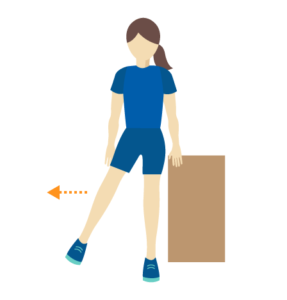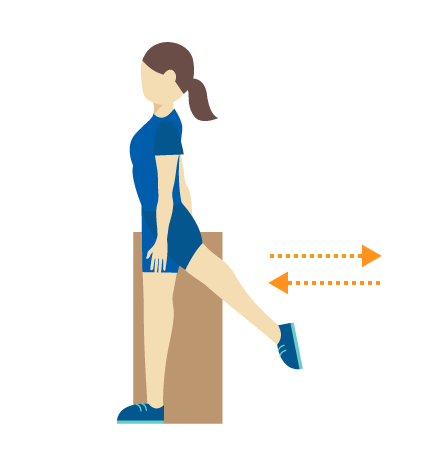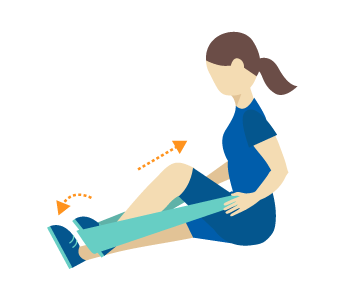Reclaim Mobility With At Home Leg Exercises For Stroke Recovery

Stroke recovery can be a long process. Each year nearly 800,000 people in the United States alone will suffer from a stroke, leaving them with ongoing physical and neurological damage. Managing the ongoing need to rebuild bodily control and strength after neurological damage is no easy task. If you have suffered from a stroke, loss of balance and control can make standing and walking difficult. While outpatient stroke recovery therapy is vital to improving this problem, you can also continue improving with the help of these at home leg exercises for stroke recovery.
At Home Leg Exercises for Stroke Recovery
Richard Sealy, director of The Rehab Practice, a private neuro-therapy rehabilitation program in the United Kingdom, regularly works with individuals, families, and caregivers to establish custom exercise routines to aid in recovery from from long-term neurological problems, like the damage caused by stroke. While he acknowledges that each patient should have a custom exercise routine specific and personal to their struggles, he recommends a series of exercises to help strengthen the legs and improve range of motion during stroke recovery.
Sealy understands the importance of fast progress after a stroke, and including ongoing at-home exercises can improve health and well-being. These low-impact strength and stretching leg exercises for stroke recovery are a good complement to use in conjunction with the Saebo MyoTrac Infiniti biofeedback system.
As with any exercise program, please consult your healthcare provider before you begin. If you notice increased pain, discomfort, or other troubling systems, stop these exercises immediately and talk to your doctor.
Exercise Set 1: Standing and Balance
Balance and coordination are often lost after a stroke. This can make simple actions, like standing and walking, difficult. In addition, weakness can occur around the muscles on the exterior of the hip area.
Exercises for standing and balance are vital to helping you regain your quality of life after a stroke. When performing these at home leg exercises, always hold onto a table or similar stable surface to avoid a fall.

Exercise 1: Basic Level Standing and Balance Exercise: Assisted Lateral Leg Swings
Hold on to a stable surface, standing straight and tall while you transfer your weight to one side. Swing the other leg to the side. Use your balance to hold this position for 10 seconds. Slowly lower your leg back down. Repeat a few times, as long as you have the strength, and then switch legs.

Exercise 2: Intermediate Standing and Balance Exercises: Assisted Knee Raises
Once you have mastered the first exercise, move on to the intermediate level. Again, hold on to a stable surface, keeping your back tall and straight. Transfer your weight to one leg, and bring the other leg up in front of you, bending the knee. Hold this position for a count of 10, and slowly lower it back down. Repeat, then switch legs.

Exercise 3: Advanced Standing and Balance Exercises: Assisted Reverse Leg Swings
Finally, progress to the advanced level. This time, stand straight and tall and transfer your weight to one leg. Swing the other leg out behind you as far as you can. Hold for 10 seconds, if you can, and lower it back down slowly. Repeat and switch legs.
This progression of exercises will strengthen the hip muscle and improve balance, so you can regain normal use of your legs. This exercise series pairs well with the Saebo MyoTrac Infiniti biofeedback triggered stimulation system.
Exercise Set 2: Bridging
Often after a stroke, the hips and the core muscle groups, which are crucial to standing and walking, become weak. At home leg exercises such as bridging help to strengthen these core muscles. Like the standing and balance exercises, bridging exercises move through a progression to help rebuild your strength and coordination.

Exercise 4: Basic Bridging Exercise - "Inner Range Quad Movement" Leg Raises
The basic bridging exercise, called “Inner Range Quad Movement”, builds strength in the thigh muscles. To perform this exercise, lay down and place a pillow or rolled towel under the knee joint. Then, press the back of the knee into the pillow or rolled towel to lift your heel off the floor.
Exercise 5: Intermediate Bridging Exercise: Ski Squats - Wall Sits
"Ski Squats" take bridging exercises to the next level. For this exercise, lean against a flat wall, placing your feet in front of you. Using the wall to support your weight and your back, slowly bend your knees to lower yourself down. Hold this position for 10 seconds, if you can. Slide back up, supporting your weight on the wall, until you are in a standing position.

Exercise 6: Advanced Bridging Exercise Ski Squats - Wall Sits with Pilates Ball
To take bridging exercises to the advanced level, repeat the “Ski Squat”, but place a gym ball between yourself and the wall when you bend your knees into the squat position.
Exercise Set 3: Clams
If the lower legs are affected after a stroke, Clams can provide strengthening and improved range of motion. Clams focuses on building strength and coordination in the lower leg, increasing range of motion and control.

Exercise 7: Basic Clams Exercise - In Sitting
Before starting Clams, you must stretch the calf muscle and build coordination in the lower body. In Sitting helps with this. In a sitting position, create a stirrup around one foot using a towel or belt, placing the stirrup around the ball of the foot. Gently pull the stirrup up towards your body to stretch the calf muscle. Then, pull it with the outer hand to turn the foot out, continuing to stretch the muscle.

Exercise 8: Intermediate Clams Exercise - Hip Openers
Once you have build some flexibility, you are ready for the Clams exercise. Lay down on your side, and bend your knees, resting one on top of the other. Then, while you keep your feet together, lift the upper knee away from the other knee, holding them apart for a count of 10 seconds. Slowly lower your knee back down. While performing this exercise, make sure that you do not roll your hips back.

Exercise 9: Advanced Clams Exercise
After mastering Clams, take it to the next level by lifting the knee and the foot of the upper leg. Again, hold the position for a count of 10 seconds. Lower it back down. Repeat a few times to build strength and range of motion.
Rebuild Strength and Coordination with At Home Leg Exercises for Stroke Recovery
Strokes can occur in people of any age, although nearly 75% of all strokes occur after the age of 65, and an individual's risk doubles after 55. Each year, approximately 600,000 people suffer from their first stroke, and an additional 185,000 have a recurrent stroke.
If you have suffered one or more strokes, it can be easy to feel discouraged at the lack of mobility and control you experience. At home leg exercises, like these, can help you regain that control and build up your strength again, so you can recover from the neurological damage of a stroke.
For extra support in advancing your recovery after a stroke, check out the many advanced products from Saebo to help you every step of the way.
Saebo Stroke Recovery Product Selector
Whether you are a caregiver, occupational therapist or even a stroke survivor yourself, Saebo provides stroke survivors young or old access to transformative and life-changing products. We pride ourselves on providing affordable, easily accessible, and cutting-edge solutions to people suffering from impaired mobility and function. We have several products to help with the stroke recovery and rehabilitation process. The SaeboStim Spa is an electrical stimulation unit and neuropathy foot bath that can aid in repairing nerve damage and help improve foot drop. Using this device before performing at home leg exercises can help make movement easier by stimulating the affected muscles to increase mobility.
Check out all of our product offerings or let us help you find which product is right for you.
All content provided on this blog is for informational purposes only and is not intended to be a substitute for professional medical advice, diagnosis, or treatment. Always seek the advice of your physician or other qualified health provider with any questions you may have regarding a medical condition. If you think you may have a medical emergency, call your doctor or 911 immediately. Reliance on any information provided by the Saebo website is solely at your own risk.
All content provided on this blog is for informational purposes only and is not intended to be a substitute for professional medical advice, diagnosis, or treatment. Always seek the advice of your physician or other qualified health providers with any questions you may have regarding a medical condition. If you think you may have a medical emergency, call your doctor or 911 immediately. Reliance on any information provided by the Saebo website is solely at your own risk.




